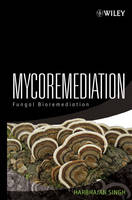Mycoremediation
 -15%
portes grátis
-15%
portes grátis
Mycoremediation
Fungal Bioremediation
Singh, Harbhajan
John Wiley & Sons Inc
12/2006
624
Dura
Inglês
9780471755012
15 a 20 dias
990
1 Introduction 1
1.1 Fungal Biodegradation and Biodeterioration 2
1.2 How a Fungus Escapes Water to Grow in Air 3
1.3 Fungal Morphology Analysis and Growth Measurement 3
1.3.1 Fungal Morphology 3
1.3.2 Analysis of Fungal Morphology 4
1.3.3 Pellet Formation and Structure 5
1.3.4 Growth Measurement 6
1.4 Mass Transfer Growth Kinetics and Bioreactors 7
1.5 Methods for Detection of Degradative Fungi 10
1.5.1 Immunological Assays 10
1.5.2 Molecular Assays 11
1.6 Fungi as Environmental Indicators 13
1.7 Fungal Attack on Coal 14
1.8 Thermophilic Alpine and Lichen-Forming Fungi 15
1.9 Mycoremediation: Fungal Bioremediation 16
1.9.1 White-Rot Fungi in Bioremediation 16
1.10 Ecology of Mycoremediation 18
1.11 Genetic Engineering of Mycoremediation 19
References 20
2 Fungal Treatment of Industrial Wastewaters 29
2.1 Introduction 29
2.2 Alternative Industrial Wastewater Bioreactors 30
2.3 Fungal Treatment of Industrial Wastewaters 31
2.3.1 Starch-Processing Wastewater 32
2.3.1.1 Background 32
2.3.1.2 Composition and Characteristics 33
2.3.1.3 Bioreactors and Fermentation 33
2.3.1.4 Enzyme Treatment 34
2.3.1.5 Production of Fungal Protein 35
2.3.2 Dairy Industry Wastewater 36
2.3.2.1 Background 36
2.3.2.2 Bioreactors and Modeling 37
2.3.2.3 Production of Fungal Biomass 39
2.3.2.4 Lactases 40
2.3.2.5 Genetics of Lactose Utilization 40
2.3.3 Pharmaceutical Industry Wastewater 41
2.3.3.1 Background 41
2.3.3.2 Process Development 42
2.3.3.3 Conclusions 42
2.3.4 Protein-Containing Wastewater 42
2.3.4.1 Background 42
2.3.4.2 Bioreactors 43
2.3.5 Oil Manufacturing Plant Wastewater 44
2.3.5.1 Background 44
2.3.5.2 Assay of Oil-Decomposing Ability 45
2.3.5.3 Bioreactors 45
2.3.6 Silage Wastewater 47
2.3.6.1 Background 47
2.3.6.2 Legislation 48
2.3.6.3 Growth of Fungi 48
2.3.6.4 On-Farm Treatment 50
2.3.6.5 Production of Fungal Biomass 50
2.3.7 Acidogenic Wastewater 50
2.3.7.1 Background 50
2.3.7.2 Bioreactors and Modeling 51
2.3.8 Olive Mill Wastewater 53
2.3.8.1 Background 53
2.3.8.2 Composition and Characteristics 54
2.3.8.3 Fermentation 54
2.3.8.4 Modeling 57
2.3.8.5 Immobilization 57
2.3.8.6 Enzyme Treatment 59
2.3.8.7 Toxicity Testing 60
2.3.8.8 Economic Importance 61
2.4 Biotechnology 62
2.5 Conclusions and Future Perspectives 63
References 63
3 Fungal Treatment of Distillery and Brewery Wastes 76
3.1 Introduction 76
3.2 Composition and Characteristics of Stillage 77
3.3 Alternative Industrial Stillage Treatment Reactors 78
3.4 Fungal Treatment of Distillery and Brewery Wastes 80
3.5 Fungal Fermentation and Decolorization 80
3.5.1 Yeasts 81
3.5.2 Filamentous Fungi 84
3.5.3 White-Rot Fungi 85
3.5.4 Mixed Cultures 86
3.6 Molasses Toxicity to Fungi 87
3.7 Factors Affecting Fungal Fermentation and Decolorization 87
3.7.1 Carbon Source 89
3.7.2 Nitrogen and Phosphorus Sources 89
3.7.3 Temperature 90
3.7.4 pH 90
3.7.5 Agitation and Aeration 90
3.7.6 Inoculum Size 91
3.7.7 Effluent Dilution Rate 91
3.8 Mechanisms of Melanoidin Degradation 92
3.9 Fungal Bioreactors for Distillery and Brewery Wastes 93
3.9.1 Fed-Batch Bioreactors 95
3.9.2 Bubble Column Bioreactors 95
3.9.3 Fluidized-Bed Bioreactors 95
3.9.4 Immobilized Bioreactors 96
3.10 Modeling 97
3.11 Economic Importance 98
3.11.1 Single-Cell Protein Production 98
3.11.2 Ethanol Production 99
3.11.3 Bioproducts 101
3.11.4 Algal Production 103
3.12 Biotechnology 103
3.13 Conclusions and Future Perspectives 104
References 106
4 Fungal Metabolism of Petroleum Hydrocarbons 115
4.1 Introduction 115
4.2 Fate of Oil in the Environment 116
4.3 Composition of Petroleum Hydrocarbons 117
4.4 Methods of Analysis of Petroleum Hydrocarbons 117
4.5 Alternative Treatment Technologies 119
4.6 Hydrocarbon-Utilizing Yeasts and Fungi 119
4.7 Fungal Methods of Assessment 121
4.7.1 Fungal Enumeration 122
4.7.2 Respirometric Tests 123
4.7.3 Soil Microcosm Tests 123
4.7.4 Miscellaneous Tests 124
4.8 Hydrocarbon Metabolism by Yeasts and Fungi 124
4.9 Taxonomic Relationship of Hydrocarbon-Utilizing Yeasts and Fungi 129
4.10 Factors Affecting Metabolism of Petroleum Hydrocarbons 130
4.10.1 Physical Nature 130
4.10.2 Temperature 130
4.10.3 pH 131
4.10.4 Oxygen 131
4.10.5 Nutrients Dispersants and Biosurfactants 131
4.11 Fungal Mechanisms of Metabolism of Petroleum Hydrocarbons 132
4.11.1 Aliphatic Hydrocarbons 133
4.11.2 Aromatic Hydrocarbons 134
4.11.3 Cooxidation of Hydrocarbons 134
4.11.4 Uptake of Hydrocarbons 134
4.12 Oxidation of Petroleum Hydrocarbons by Fungal Enzymes 135
4.13 Cytochrome P450 Enzyme Systems 136
4.14 Economic Importance 137
4.14.1 Single-Cell Protein 137
4.14.2 Surfactant Production 137
4.14.3 Metabolite Overproduction 138
4.15 Biotechnology and Bioengineering 139
4.16 Conclusions and Future Perspectives 140
References 140
5 Fungal Degradation of Polychlorinated Biphenyls and Dioxins 149
5.1 Introduction 149
5.2 Nomenclature 150
5.3 Bioaccumulation and Toxicity 150
5.4 Alternative PCB Remediation Technologies 151
5.5 Analysis of Polychlorinated Biphenyls 151
5.6 Bioavailability of Polychlorinated Biphenyls 153
5.7 Fungal Degradation of Polychlorinated Biphenyls 154
5.7.1 Filamentous Fungi 154
5.7.2 Yeasts 156
5.7.3 White-Rot Fungi 158
5.7.3.1 White-Rot Fungal Bioreactors 158
5.7.3.2 Degradation and Mineralization 159
5.7.3.3 Effects of Chlorination Grades and Patterns 162
5.7.3.4 Metabolic Products and Pathways 163
5.7.3.5 Role of Manganese in PCB Biodegradation 167
5.7.3.6 PCB Bioremediation in Soils 167
5.7.3.7 Biotransformation of PCBs by Laccases 169
5.7.3.8 Comparison with Bacterial Systems 171
5.8 Fungal Degradation of Dioxins 172
5.9 Genetic Manipulation 173
5.10 Conclusions and Future Perspectives 173
References 174
6 Fungal Degradation of Pesticides 181
6.1 Introduction 181
6.2 Classification 182
6.3 Biosensors for Detection of Pesticides 182
6.4 Fungal Degradation of Insecticides 184
6.4.1 Chlorinated Compounds 184
6.4.2 Organophosphorus Compounds 189
6.4.3 Miscellaneous Compounds 190
6.5 Fungal Degradation of Herbicides 190
6.5.1 Phenoxyalkanoate Compounds 190
6.5.2 Phenylamide Compounds 194
6.5.2.1 Acylanilides 194
6.5.2.2 Phenylureas 195
6.5.2.3 Phenylcarbamates 197
6.5.3 s-Triazine Compounds 198
6.5.4 Miscellaneous Compounds 199
6.6 Fungal Degradation of Fungicides 199
6.6.1 Organomercurial Compounds 200
6.6.2 Organosulfur Compounds 200
6.6.3 Organophosphorus Compounds 203
6.6.4 Aromatic and Heterocyclic Compounds 203
6.7 Biotransformation of Pesticides by Fungal Enzymes 203
6.8 Genetic Manipulation 205
6.9 Conclusions and Future Perspectives 207
References 208
7 Fungal Metabolism of Phenols Chlorophenols and Pentachlorophenol 215
7.1 Introduction 215
7.2 Alternative Treatment Technologies 216
7.2.1 Physicochemical Methods 216
7.2.2 Biological Methods 217
7.2.2.1 Metabolism by Bacteria 217
7.2.2.2 Metabolism by Actinomycetes 218
7.2.2.3 Metabolism by Algae and Higher Plants 218
7.3 Fungal Biosensors for Determination of Various Types of Phenols 219
7.3.1 Enzyme-Based Systems 219
7.3.2 Biological Affinity Assays (Immunoassays) 221
7.4 Methods of Analysis of Various Types of Phenols 221
7.5 Fungal Bioreactors for Removal of Various Types of Phenols 221
7.5.1 Rotating Tube Bioreactors 222
7.5.2 Membrane Bioreactors 222
7.5.3 Packed-Bed/Immobilized Bioreactors 222
7.5.4 Upflow Column Bioreactors 225
7.5.5 Miscellaneous Bioreactors 226
7.6 Fungal Metabolism of Phenols Chlorophenols and Pentachlorophenol 226
7.6.1 Fungal Metabolism of Phenols 226
7.6.2 Fungal Metabolism of Chlorophenols 230
7.6.3 Fungal Metabolism of Pentachlorophenol 230
7.7 Factors Affecting Fungal Metabolism of Various Types of Phenols 231
7.7.1 Effect of Static Versus Agitated Culture Conditions 231
7.7.2 Effect of Culture Age Type of Inoculum and Carbon and Nitrogen Sources 234
7.8 Physiological Alterations of Fungi by Phenols 235
7.9 Taxonomic Relationship of Phenol-Utilizing Yeasts and Fungi 236
7.10 Mechanisms of Metabolism Metabolic Pathways and Metabolites 237
7.11 Degradation of Phenols by Fungal Enzymes 245
7.11.1 Peroxidase-Catalyzed Degradation 246
7.11.1.1 Peroxidase Bioreactors 246
7.11.2 Polyphenol Oxidase/Tyrosinase-Catalyzed Degradation 250
7.11.2.1 Polyphenol Oxidase/Tyrosinase Bioreactors 251
7.11.3 Laccase-Catalyzed Degradation 253
7.11.3.1 Influence of Cosubstrates 257
7.11.3.2 Laccase Bioreactors 258
7.11.4 Miscellaneous Enzymes 259
7.12 Fungal Transformation of Pentachlorophenol in Soils 261
7.12.1 Bound Residue Formation 261
7.12.2 Degradation and Mineralization 263
7.12.3 Fungal Augmentation 264
7.13 Cytochrome P450 Systems in Degradation of Phenols 265
7.14 Conclusions and Future Perspectives 266
References 267
8 Fungal Metabolism of Polycyclic Aromatic Hydrocarbons 283
8.1 Introduction 283
8.2 Occurrence of PAHs in the Environment 284
8.3 Alternative PAH Metabolism 285
8.3.1 Bacteria 285
8.3.2 Algae Cyanobacteria and Higher Plants 287
8.4 Fungal Metabolism of PAHs 287
8.4.1 Fungal Metabolism of Naphthalene 296
8.4.2 Fungal Metabolism of Acenaphthene 296
8.4.3 Fungal Metabolism of Anthracene 296
8.4.4 Fungal Metabolism of Phenanthrene 297
8.4.5 Fungal Metabolism of Fluorene 298
8.4.6 Fungal Metabolism of Fluoranthene 300
8.4.7 Fungal Metabolism of Chrysene 300
8.4.8 Fungal Metabolism of Pyrene 302
8.4.9 Fungal Metabolism of Benz[a]anthracene 304
8.4.10 Fungal Metabolism of Benzo[a]pyrene 305
8.5 Mutagenicity of Fungal Metabolites of PAHs 306
8.6 Fungal Bioreactors for Removal of PAHs 306
8.6.1 Immobilized Bioreactors 307
8.6.2 Closed-Batch Feed Bioreactors 307
8.6.3 Compost Bioreactors 310
8.6.4 Miscellaneous Bioreactors 311
8.7 PAH Degradation by Fungal Enzymes 311
8.7.1 Peroxidase-Catalyzed Degradation 312
8.7.1.1 Role of Miscible Solvents 314
8.7.1.2 Influence of Cyclodextrins 315
8.7.2 Laccase-Catalyzed Degradation 316
8.7.2.1 Laccase Bioreactors 319
8.7.2.2 Influence of Mediators 319
8.7.3 Miscellaneous Enzymes 320
8.8 Cytochrome P450 in Degradation of PAHs 322
8.9 Fungal Degradation of PAHs in Soils 323
8.9.1 Influence of Cosubstrates and Surfactants 324
8.9.2 Fate of PAH Disappearance 330
8.9.2.1 PAH Degradation and Mineralization 330
8.9.2.2 Bound Residue Formation 333
8.9.3 Factors Affecting Biodegradation of PAHs 334
8.10 Fungal Metabolism of Complex PAH Mixtures 335
8.11 PAH Degradation by Fungal-Bacterial Co-cultures 336
8.12 Biotechnology and Bioengineering 337
8.13 Conclusions and Future Perspectives 339
References 340
9 Fungal Lignin Degradation and Decolorization of Pulp and Paper Mill Effluents 357
9.1 Introduction 357
9.2 Distribution and Structure of Lignin 358
9.3 Lignin-Degrading Microorganisms 360
9.3.1 Bacterial Degradation 360
9.3.2 Fungal Degradation 360
9.4 Fungal Lignin-Degrading Enzymes 362
9.4.1 Lignin Peroxidases 363
9.4.2 Manganese Peroxidases 368
9.4.3 Laccases 372
9.4.4 Hydrogen Peroxide-Producing Enzymes 375
9.4.5 Reactive Oxygen Species 378
9.4.6 Miscellaneous Enzymes 380
9.5 Mechanisms of Fungal Lignin Degradation and Metabolic Products 381
9.6 Fungal Decolorization of Pulp and Paper Mill Effluents 382
9.7 Fungal Bioreactors for Decolorization of Pulp and Paper Mill Effluents 384
9.7.1 Batch and Continuous Bioreactors 384
9.7.2 Upflow Column Bioreactors 387
9.7.3 Immobilized Bioreactors 388
9.7.4 Miscellaneous Bioreactors 389
9.8 Factors Affecting Decolorization of Pulp and Paper Mill Effluents 391
9.8.1 Carbon Cosubstrate 391
9.8.2 Nitrogen Phosphorus Sulfur and Chloride Concentrations 391
9.8.3 Hydrogen Ion Concentration and Temperature 395
9.8.4 Dilution of Effluent 395
9.8.5 Inoculum Dose and Nature 395
9.8.6 Static Versus Agitated Culture Conditions 396
9.9 Effect of Fungal Treatment on Chlorophenols and Chloroaldehydes in Effluents 396
9.10 Decolorization of Effluents by Fungal Enzymes 397
9.11 Wetlands Treatment 399
9.12 Conclusions and Future Perspectives 399
References 400
10 Fungal Decolorization and Degradation of Dyes 420
10.1 Introduction 420
10.2 Classification Structure and Color Measurements 421
10.3 Legislation and Regulations 422
10.4 Alternative Decolorization Treatment Technologies 423
10.4.1 Physicochemical Methods 423
10.4.2 Biological Methods 425
10.4.2.1 Degradation by Bacteria 425
10.4.2.2 Degradation by Actinomycetes 425
10.4.2.3 Degradation by Algae and Higher Plants 425
10.5 Fungal Decolorization and Degradation of Dyes 426
10.5.1 Azo Dyes 426
10.5.2 Phthalocyanine Dyes 434
10.5.3 Anthraquinone Dyes 434
10.5.4 Heterocyclic Dyes 435
10.5.5 Indigo Dyes 435
10.5.6 Polymeric Dyes 435
10.5.7 Triphenylmethane Dyes 435
10.6 Yeast Decolorization and Degradation of Dyes 436
10.7 White-Rot Fungal Decolorization and Degradation of Dyes 438
10.8 Mechanisms of Fungal Decolorization and Degradation of Dyes 438
10.9 Metabolic Products and Pathways 440
10.10 Factors Affecting Fungal Decolorization and Degradation of Dyes 442
10.10.1 Media Composition 443
10.10.2 Static Versus Agitated Culture Conditions 447
10.10.3 pH and Temperature 447
10.10.4 C and N Sources TOC/N Ratio and Salts 447
10.10.5 Initial Dye Concentration 448
10.11 Fungal Dye Decolorization and Degradation Bioreactors 448
10.11.1 Rotating Drum Stirred-Tank and Membrane Bioreactors 452
10.11.2 Packed- and Fluidized-Bed Bioreactors 452
10.11.3 Immobilized Bioreactors 453
10.12 Decolorization and Degradation of Dyes by Fungal Enzymes 454
10.12.1 Peroxidase-Catalyzed Decolorization and Degradation of Dyes 455
10.12.1.1 Peroxidase Bioreactors 461
10.12.2 Laccase-Catalyzed Decolorization and Degradation of Dyes 462
10.12.2.1 Laccase Bioreactors 466
10.12.2.2 Influence of Mediators 467
10.13 Decolorization of Artificial Textile Effluent 467
10.14 Sequential Dye Decolorization 470
10.15 Conclusions and Future Perspectives 470
References 472
11 Fungal Biosorption of Heavy Metals 484
11.1 Introduction 484
11.2 Biosorption and Bioaccumulation of Heavy Metals 485
11.3 Evaluation of Sorption Performance 486
11.4 Mechanisms of Fungal Biosorption of Heavy Metals 487
11.5 Fungal Biosorption Reactors for Heavy Metals 491
11.5.1 Types of Reactors 491
11.5.1.1 Batch Stirred-Tank Reactors 491
11.5.1.2 Continuous-Flow Stirred-Tank Reactors 491
11.5.1.3 Fixed Packed-Bed Reactors 491
11.5.1.4 Immobilized Reactors 491
11.5.2 Models of Process Development 496
11.5.3 Desorption and Regeneration 498
11.5.4 Effect of Effluent Composition 499
11.6 Applications of Fungal Biosorption of Heavy Metals 499
11.6.1 Biosorption by Filamentous Fungi 499
11.6.2 Biosorption by White-Rot Fungi 504
11.6.3 Biosorption by Yeasts 505
11.6.4 Biosorption by Aspergillus niger 507
11.6.4.1 Role in Soil Bioremediation 509
11.7 Fungal Biosorption of Herbicides and Phenols 509
11.8 Fungal Biosorption of Dyes 512
11.9 Fungal Binary and Ternary Biosorption Systems 512
11.9.1 Binary Biosorption Systems 512
11.9.2 Ternary Biosorption Systems 515
11.9.3 Effect of Co-cations 516
11.10 Biosorption of Heavy Metal Anions 516
11.11 Metal Ion Resistance 517
11.12 Conclusions and Future Perspectives 518
References 519
12 Mycorrhizal Fungi in Rhizosphere Remediation 533
12.1 Introduction 533
12.2 Classification of Mycorrhizal Fungi 534
12.3 Functions of Mycorrhizal Mycelium 535
12.4 Methods for Studying Mycorrhizal Fungi 536
12.5 Molecular Mechanisms of Mycorrhizal Symbiosis 538
12.6 Metabolism of Mycorrhizal Fungi 539
12.6.1 General Metabolism 539
12.6.2 Degradative Metabolism 539
12.7 Uptake of Toxic Metals 541
12.7.1 Metal Tolerance in Mycorrhizal Symbiosis 541
12.7.2 Mechanisms of Response to Metals 543
12.7.3 Transport of Radionuclides 545
12.7.4 Genetics of Metal Tolerance 547
12.8 Petroleum Hydrocarbon Degradation 547
12.9 Lignin and Phenolic Degradation 549
12.10 PAH and TNT Degradation 552
12.11 PCB Degradation 555
12.12 Herbicide Degradation 555
12.13 Comparison of Mycorrhizal and White-Rot Fungi 556
12.14 Conclusions and Future Perspectives 558
References 559
Index 573
1 Introduction 1
1.1 Fungal Biodegradation and Biodeterioration 2
1.2 How a Fungus Escapes Water to Grow in Air 3
1.3 Fungal Morphology Analysis and Growth Measurement 3
1.3.1 Fungal Morphology 3
1.3.2 Analysis of Fungal Morphology 4
1.3.3 Pellet Formation and Structure 5
1.3.4 Growth Measurement 6
1.4 Mass Transfer Growth Kinetics and Bioreactors 7
1.5 Methods for Detection of Degradative Fungi 10
1.5.1 Immunological Assays 10
1.5.2 Molecular Assays 11
1.6 Fungi as Environmental Indicators 13
1.7 Fungal Attack on Coal 14
1.8 Thermophilic Alpine and Lichen-Forming Fungi 15
1.9 Mycoremediation: Fungal Bioremediation 16
1.9.1 White-Rot Fungi in Bioremediation 16
1.10 Ecology of Mycoremediation 18
1.11 Genetic Engineering of Mycoremediation 19
References 20
2 Fungal Treatment of Industrial Wastewaters 29
2.1 Introduction 29
2.2 Alternative Industrial Wastewater Bioreactors 30
2.3 Fungal Treatment of Industrial Wastewaters 31
2.3.1 Starch-Processing Wastewater 32
2.3.1.1 Background 32
2.3.1.2 Composition and Characteristics 33
2.3.1.3 Bioreactors and Fermentation 33
2.3.1.4 Enzyme Treatment 34
2.3.1.5 Production of Fungal Protein 35
2.3.2 Dairy Industry Wastewater 36
2.3.2.1 Background 36
2.3.2.2 Bioreactors and Modeling 37
2.3.2.3 Production of Fungal Biomass 39
2.3.2.4 Lactases 40
2.3.2.5 Genetics of Lactose Utilization 40
2.3.3 Pharmaceutical Industry Wastewater 41
2.3.3.1 Background 41
2.3.3.2 Process Development 42
2.3.3.3 Conclusions 42
2.3.4 Protein-Containing Wastewater 42
2.3.4.1 Background 42
2.3.4.2 Bioreactors 43
2.3.5 Oil Manufacturing Plant Wastewater 44
2.3.5.1 Background 44
2.3.5.2 Assay of Oil-Decomposing Ability 45
2.3.5.3 Bioreactors 45
2.3.6 Silage Wastewater 47
2.3.6.1 Background 47
2.3.6.2 Legislation 48
2.3.6.3 Growth of Fungi 48
2.3.6.4 On-Farm Treatment 50
2.3.6.5 Production of Fungal Biomass 50
2.3.7 Acidogenic Wastewater 50
2.3.7.1 Background 50
2.3.7.2 Bioreactors and Modeling 51
2.3.8 Olive Mill Wastewater 53
2.3.8.1 Background 53
2.3.8.2 Composition and Characteristics 54
2.3.8.3 Fermentation 54
2.3.8.4 Modeling 57
2.3.8.5 Immobilization 57
2.3.8.6 Enzyme Treatment 59
2.3.8.7 Toxicity Testing 60
2.3.8.8 Economic Importance 61
2.4 Biotechnology 62
2.5 Conclusions and Future Perspectives 63
References 63
3 Fungal Treatment of Distillery and Brewery Wastes 76
3.1 Introduction 76
3.2 Composition and Characteristics of Stillage 77
3.3 Alternative Industrial Stillage Treatment Reactors 78
3.4 Fungal Treatment of Distillery and Brewery Wastes 80
3.5 Fungal Fermentation and Decolorization 80
3.5.1 Yeasts 81
3.5.2 Filamentous Fungi 84
3.5.3 White-Rot Fungi 85
3.5.4 Mixed Cultures 86
3.6 Molasses Toxicity to Fungi 87
3.7 Factors Affecting Fungal Fermentation and Decolorization 87
3.7.1 Carbon Source 89
3.7.2 Nitrogen and Phosphorus Sources 89
3.7.3 Temperature 90
3.7.4 pH 90
3.7.5 Agitation and Aeration 90
3.7.6 Inoculum Size 91
3.7.7 Effluent Dilution Rate 91
3.8 Mechanisms of Melanoidin Degradation 92
3.9 Fungal Bioreactors for Distillery and Brewery Wastes 93
3.9.1 Fed-Batch Bioreactors 95
3.9.2 Bubble Column Bioreactors 95
3.9.3 Fluidized-Bed Bioreactors 95
3.9.4 Immobilized Bioreactors 96
3.10 Modeling 97
3.11 Economic Importance 98
3.11.1 Single-Cell Protein Production 98
3.11.2 Ethanol Production 99
3.11.3 Bioproducts 101
3.11.4 Algal Production 103
3.12 Biotechnology 103
3.13 Conclusions and Future Perspectives 104
References 106
4 Fungal Metabolism of Petroleum Hydrocarbons 115
4.1 Introduction 115
4.2 Fate of Oil in the Environment 116
4.3 Composition of Petroleum Hydrocarbons 117
4.4 Methods of Analysis of Petroleum Hydrocarbons 117
4.5 Alternative Treatment Technologies 119
4.6 Hydrocarbon-Utilizing Yeasts and Fungi 119
4.7 Fungal Methods of Assessment 121
4.7.1 Fungal Enumeration 122
4.7.2 Respirometric Tests 123
4.7.3 Soil Microcosm Tests 123
4.7.4 Miscellaneous Tests 124
4.8 Hydrocarbon Metabolism by Yeasts and Fungi 124
4.9 Taxonomic Relationship of Hydrocarbon-Utilizing Yeasts and Fungi 129
4.10 Factors Affecting Metabolism of Petroleum Hydrocarbons 130
4.10.1 Physical Nature 130
4.10.2 Temperature 130
4.10.3 pH 131
4.10.4 Oxygen 131
4.10.5 Nutrients Dispersants and Biosurfactants 131
4.11 Fungal Mechanisms of Metabolism of Petroleum Hydrocarbons 132
4.11.1 Aliphatic Hydrocarbons 133
4.11.2 Aromatic Hydrocarbons 134
4.11.3 Cooxidation of Hydrocarbons 134
4.11.4 Uptake of Hydrocarbons 134
4.12 Oxidation of Petroleum Hydrocarbons by Fungal Enzymes 135
4.13 Cytochrome P450 Enzyme Systems 136
4.14 Economic Importance 137
4.14.1 Single-Cell Protein 137
4.14.2 Surfactant Production 137
4.14.3 Metabolite Overproduction 138
4.15 Biotechnology and Bioengineering 139
4.16 Conclusions and Future Perspectives 140
References 140
5 Fungal Degradation of Polychlorinated Biphenyls and Dioxins 149
5.1 Introduction 149
5.2 Nomenclature 150
5.3 Bioaccumulation and Toxicity 150
5.4 Alternative PCB Remediation Technologies 151
5.5 Analysis of Polychlorinated Biphenyls 151
5.6 Bioavailability of Polychlorinated Biphenyls 153
5.7 Fungal Degradation of Polychlorinated Biphenyls 154
5.7.1 Filamentous Fungi 154
5.7.2 Yeasts 156
5.7.3 White-Rot Fungi 158
5.7.3.1 White-Rot Fungal Bioreactors 158
5.7.3.2 Degradation and Mineralization 159
5.7.3.3 Effects of Chlorination Grades and Patterns 162
5.7.3.4 Metabolic Products and Pathways 163
5.7.3.5 Role of Manganese in PCB Biodegradation 167
5.7.3.6 PCB Bioremediation in Soils 167
5.7.3.7 Biotransformation of PCBs by Laccases 169
5.7.3.8 Comparison with Bacterial Systems 171
5.8 Fungal Degradation of Dioxins 172
5.9 Genetic Manipulation 173
5.10 Conclusions and Future Perspectives 173
References 174
6 Fungal Degradation of Pesticides 181
6.1 Introduction 181
6.2 Classification 182
6.3 Biosensors for Detection of Pesticides 182
6.4 Fungal Degradation of Insecticides 184
6.4.1 Chlorinated Compounds 184
6.4.2 Organophosphorus Compounds 189
6.4.3 Miscellaneous Compounds 190
6.5 Fungal Degradation of Herbicides 190
6.5.1 Phenoxyalkanoate Compounds 190
6.5.2 Phenylamide Compounds 194
6.5.2.1 Acylanilides 194
6.5.2.2 Phenylureas 195
6.5.2.3 Phenylcarbamates 197
6.5.3 s-Triazine Compounds 198
6.5.4 Miscellaneous Compounds 199
6.6 Fungal Degradation of Fungicides 199
6.6.1 Organomercurial Compounds 200
6.6.2 Organosulfur Compounds 200
6.6.3 Organophosphorus Compounds 203
6.6.4 Aromatic and Heterocyclic Compounds 203
6.7 Biotransformation of Pesticides by Fungal Enzymes 203
6.8 Genetic Manipulation 205
6.9 Conclusions and Future Perspectives 207
References 208
7 Fungal Metabolism of Phenols Chlorophenols and Pentachlorophenol 215
7.1 Introduction 215
7.2 Alternative Treatment Technologies 216
7.2.1 Physicochemical Methods 216
7.2.2 Biological Methods 217
7.2.2.1 Metabolism by Bacteria 217
7.2.2.2 Metabolism by Actinomycetes 218
7.2.2.3 Metabolism by Algae and Higher Plants 218
7.3 Fungal Biosensors for Determination of Various Types of Phenols 219
7.3.1 Enzyme-Based Systems 219
7.3.2 Biological Affinity Assays (Immunoassays) 221
7.4 Methods of Analysis of Various Types of Phenols 221
7.5 Fungal Bioreactors for Removal of Various Types of Phenols 221
7.5.1 Rotating Tube Bioreactors 222
7.5.2 Membrane Bioreactors 222
7.5.3 Packed-Bed/Immobilized Bioreactors 222
7.5.4 Upflow Column Bioreactors 225
7.5.5 Miscellaneous Bioreactors 226
7.6 Fungal Metabolism of Phenols Chlorophenols and Pentachlorophenol 226
7.6.1 Fungal Metabolism of Phenols 226
7.6.2 Fungal Metabolism of Chlorophenols 230
7.6.3 Fungal Metabolism of Pentachlorophenol 230
7.7 Factors Affecting Fungal Metabolism of Various Types of Phenols 231
7.7.1 Effect of Static Versus Agitated Culture Conditions 231
7.7.2 Effect of Culture Age Type of Inoculum and Carbon and Nitrogen Sources 234
7.8 Physiological Alterations of Fungi by Phenols 235
7.9 Taxonomic Relationship of Phenol-Utilizing Yeasts and Fungi 236
7.10 Mechanisms of Metabolism Metabolic Pathways and Metabolites 237
7.11 Degradation of Phenols by Fungal Enzymes 245
7.11.1 Peroxidase-Catalyzed Degradation 246
7.11.1.1 Peroxidase Bioreactors 246
7.11.2 Polyphenol Oxidase/Tyrosinase-Catalyzed Degradation 250
7.11.2.1 Polyphenol Oxidase/Tyrosinase Bioreactors 251
7.11.3 Laccase-Catalyzed Degradation 253
7.11.3.1 Influence of Cosubstrates 257
7.11.3.2 Laccase Bioreactors 258
7.11.4 Miscellaneous Enzymes 259
7.12 Fungal Transformation of Pentachlorophenol in Soils 261
7.12.1 Bound Residue Formation 261
7.12.2 Degradation and Mineralization 263
7.12.3 Fungal Augmentation 264
7.13 Cytochrome P450 Systems in Degradation of Phenols 265
7.14 Conclusions and Future Perspectives 266
References 267
8 Fungal Metabolism of Polycyclic Aromatic Hydrocarbons 283
8.1 Introduction 283
8.2 Occurrence of PAHs in the Environment 284
8.3 Alternative PAH Metabolism 285
8.3.1 Bacteria 285
8.3.2 Algae Cyanobacteria and Higher Plants 287
8.4 Fungal Metabolism of PAHs 287
8.4.1 Fungal Metabolism of Naphthalene 296
8.4.2 Fungal Metabolism of Acenaphthene 296
8.4.3 Fungal Metabolism of Anthracene 296
8.4.4 Fungal Metabolism of Phenanthrene 297
8.4.5 Fungal Metabolism of Fluorene 298
8.4.6 Fungal Metabolism of Fluoranthene 300
8.4.7 Fungal Metabolism of Chrysene 300
8.4.8 Fungal Metabolism of Pyrene 302
8.4.9 Fungal Metabolism of Benz[a]anthracene 304
8.4.10 Fungal Metabolism of Benzo[a]pyrene 305
8.5 Mutagenicity of Fungal Metabolites of PAHs 306
8.6 Fungal Bioreactors for Removal of PAHs 306
8.6.1 Immobilized Bioreactors 307
8.6.2 Closed-Batch Feed Bioreactors 307
8.6.3 Compost Bioreactors 310
8.6.4 Miscellaneous Bioreactors 311
8.7 PAH Degradation by Fungal Enzymes 311
8.7.1 Peroxidase-Catalyzed Degradation 312
8.7.1.1 Role of Miscible Solvents 314
8.7.1.2 Influence of Cyclodextrins 315
8.7.2 Laccase-Catalyzed Degradation 316
8.7.2.1 Laccase Bioreactors 319
8.7.2.2 Influence of Mediators 319
8.7.3 Miscellaneous Enzymes 320
8.8 Cytochrome P450 in Degradation of PAHs 322
8.9 Fungal Degradation of PAHs in Soils 323
8.9.1 Influence of Cosubstrates and Surfactants 324
8.9.2 Fate of PAH Disappearance 330
8.9.2.1 PAH Degradation and Mineralization 330
8.9.2.2 Bound Residue Formation 333
8.9.3 Factors Affecting Biodegradation of PAHs 334
8.10 Fungal Metabolism of Complex PAH Mixtures 335
8.11 PAH Degradation by Fungal-Bacterial Co-cultures 336
8.12 Biotechnology and Bioengineering 337
8.13 Conclusions and Future Perspectives 339
References 340
9 Fungal Lignin Degradation and Decolorization of Pulp and Paper Mill Effluents 357
9.1 Introduction 357
9.2 Distribution and Structure of Lignin 358
9.3 Lignin-Degrading Microorganisms 360
9.3.1 Bacterial Degradation 360
9.3.2 Fungal Degradation 360
9.4 Fungal Lignin-Degrading Enzymes 362
9.4.1 Lignin Peroxidases 363
9.4.2 Manganese Peroxidases 368
9.4.3 Laccases 372
9.4.4 Hydrogen Peroxide-Producing Enzymes 375
9.4.5 Reactive Oxygen Species 378
9.4.6 Miscellaneous Enzymes 380
9.5 Mechanisms of Fungal Lignin Degradation and Metabolic Products 381
9.6 Fungal Decolorization of Pulp and Paper Mill Effluents 382
9.7 Fungal Bioreactors for Decolorization of Pulp and Paper Mill Effluents 384
9.7.1 Batch and Continuous Bioreactors 384
9.7.2 Upflow Column Bioreactors 387
9.7.3 Immobilized Bioreactors 388
9.7.4 Miscellaneous Bioreactors 389
9.8 Factors Affecting Decolorization of Pulp and Paper Mill Effluents 391
9.8.1 Carbon Cosubstrate 391
9.8.2 Nitrogen Phosphorus Sulfur and Chloride Concentrations 391
9.8.3 Hydrogen Ion Concentration and Temperature 395
9.8.4 Dilution of Effluent 395
9.8.5 Inoculum Dose and Nature 395
9.8.6 Static Versus Agitated Culture Conditions 396
9.9 Effect of Fungal Treatment on Chlorophenols and Chloroaldehydes in Effluents 396
9.10 Decolorization of Effluents by Fungal Enzymes 397
9.11 Wetlands Treatment 399
9.12 Conclusions and Future Perspectives 399
References 400
10 Fungal Decolorization and Degradation of Dyes 420
10.1 Introduction 420
10.2 Classification Structure and Color Measurements 421
10.3 Legislation and Regulations 422
10.4 Alternative Decolorization Treatment Technologies 423
10.4.1 Physicochemical Methods 423
10.4.2 Biological Methods 425
10.4.2.1 Degradation by Bacteria 425
10.4.2.2 Degradation by Actinomycetes 425
10.4.2.3 Degradation by Algae and Higher Plants 425
10.5 Fungal Decolorization and Degradation of Dyes 426
10.5.1 Azo Dyes 426
10.5.2 Phthalocyanine Dyes 434
10.5.3 Anthraquinone Dyes 434
10.5.4 Heterocyclic Dyes 435
10.5.5 Indigo Dyes 435
10.5.6 Polymeric Dyes 435
10.5.7 Triphenylmethane Dyes 435
10.6 Yeast Decolorization and Degradation of Dyes 436
10.7 White-Rot Fungal Decolorization and Degradation of Dyes 438
10.8 Mechanisms of Fungal Decolorization and Degradation of Dyes 438
10.9 Metabolic Products and Pathways 440
10.10 Factors Affecting Fungal Decolorization and Degradation of Dyes 442
10.10.1 Media Composition 443
10.10.2 Static Versus Agitated Culture Conditions 447
10.10.3 pH and Temperature 447
10.10.4 C and N Sources TOC/N Ratio and Salts 447
10.10.5 Initial Dye Concentration 448
10.11 Fungal Dye Decolorization and Degradation Bioreactors 448
10.11.1 Rotating Drum Stirred-Tank and Membrane Bioreactors 452
10.11.2 Packed- and Fluidized-Bed Bioreactors 452
10.11.3 Immobilized Bioreactors 453
10.12 Decolorization and Degradation of Dyes by Fungal Enzymes 454
10.12.1 Peroxidase-Catalyzed Decolorization and Degradation of Dyes 455
10.12.1.1 Peroxidase Bioreactors 461
10.12.2 Laccase-Catalyzed Decolorization and Degradation of Dyes 462
10.12.2.1 Laccase Bioreactors 466
10.12.2.2 Influence of Mediators 467
10.13 Decolorization of Artificial Textile Effluent 467
10.14 Sequential Dye Decolorization 470
10.15 Conclusions and Future Perspectives 470
References 472
11 Fungal Biosorption of Heavy Metals 484
11.1 Introduction 484
11.2 Biosorption and Bioaccumulation of Heavy Metals 485
11.3 Evaluation of Sorption Performance 486
11.4 Mechanisms of Fungal Biosorption of Heavy Metals 487
11.5 Fungal Biosorption Reactors for Heavy Metals 491
11.5.1 Types of Reactors 491
11.5.1.1 Batch Stirred-Tank Reactors 491
11.5.1.2 Continuous-Flow Stirred-Tank Reactors 491
11.5.1.3 Fixed Packed-Bed Reactors 491
11.5.1.4 Immobilized Reactors 491
11.5.2 Models of Process Development 496
11.5.3 Desorption and Regeneration 498
11.5.4 Effect of Effluent Composition 499
11.6 Applications of Fungal Biosorption of Heavy Metals 499
11.6.1 Biosorption by Filamentous Fungi 499
11.6.2 Biosorption by White-Rot Fungi 504
11.6.3 Biosorption by Yeasts 505
11.6.4 Biosorption by Aspergillus niger 507
11.6.4.1 Role in Soil Bioremediation 509
11.7 Fungal Biosorption of Herbicides and Phenols 509
11.8 Fungal Biosorption of Dyes 512
11.9 Fungal Binary and Ternary Biosorption Systems 512
11.9.1 Binary Biosorption Systems 512
11.9.2 Ternary Biosorption Systems 515
11.9.3 Effect of Co-cations 516
11.10 Biosorption of Heavy Metal Anions 516
11.11 Metal Ion Resistance 517
11.12 Conclusions and Future Perspectives 518
References 519
12 Mycorrhizal Fungi in Rhizosphere Remediation 533
12.1 Introduction 533
12.2 Classification of Mycorrhizal Fungi 534
12.3 Functions of Mycorrhizal Mycelium 535
12.4 Methods for Studying Mycorrhizal Fungi 536
12.5 Molecular Mechanisms of Mycorrhizal Symbiosis 538
12.6 Metabolism of Mycorrhizal Fungi 539
12.6.1 General Metabolism 539
12.6.2 Degradative Metabolism 539
12.7 Uptake of Toxic Metals 541
12.7.1 Metal Tolerance in Mycorrhizal Symbiosis 541
12.7.2 Mechanisms of Response to Metals 543
12.7.3 Transport of Radionuclides 545
12.7.4 Genetics of Metal Tolerance 547
12.8 Petroleum Hydrocarbon Degradation 547
12.9 Lignin and Phenolic Degradation 549
12.10 PAH and TNT Degradation 552
12.11 PCB Degradation 555
12.12 Herbicide Degradation 555
12.13 Comparison of Mycorrhizal and White-Rot Fungi 556
12.14 Conclusions and Future Perspectives 558
References 559
Index 573
















